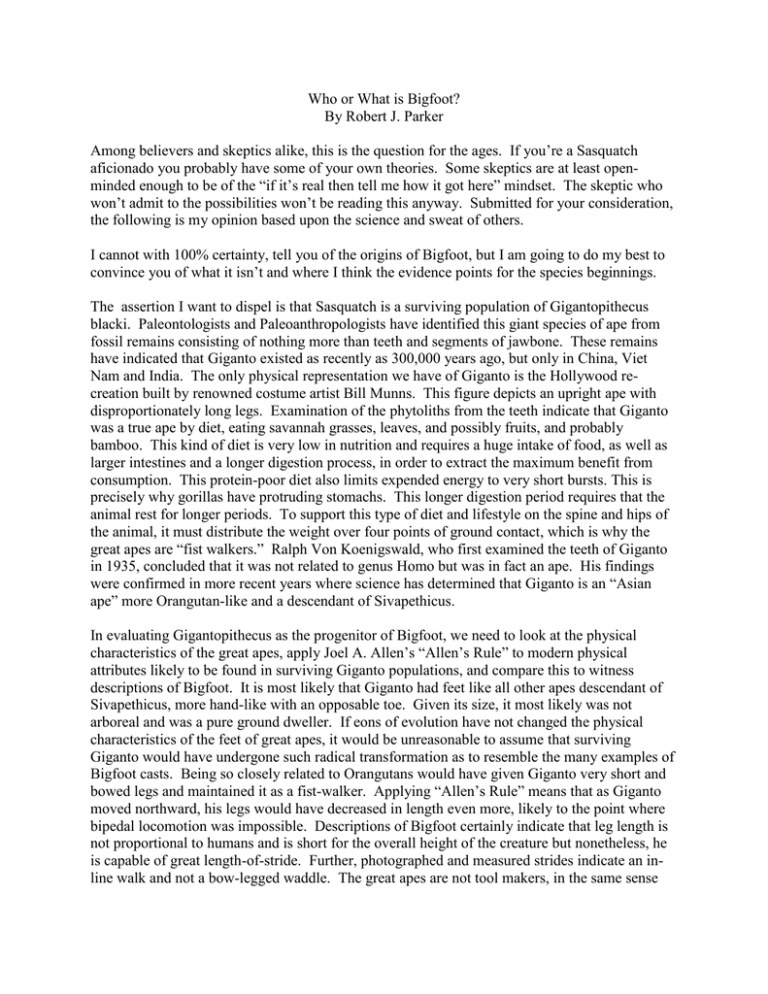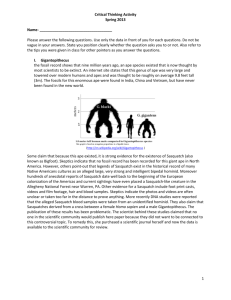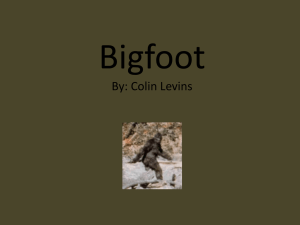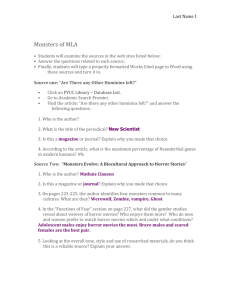here - Snohomish County Sasquatch
advertisement

Who or What is Bigfoot? By Robert J. Parker Among believers and skeptics alike, this is the question for the ages. If you’re a Sasquatch aficionado you probably have some of your own theories. Some skeptics are at least openminded enough to be of the “if it’s real then tell me how it got here” mindset. The skeptic who won’t admit to the possibilities won’t be reading this anyway. Submitted for your consideration, the following is my opinion based upon the science and sweat of others. I cannot with 100% certainty, tell you of the origins of Bigfoot, but I am going to do my best to convince you of what it isn’t and where I think the evidence points for the species beginnings. The assertion I want to dispel is that Sasquatch is a surviving population of Gigantopithecus blacki. Paleontologists and Paleoanthropologists have identified this giant species of ape from fossil remains consisting of nothing more than teeth and segments of jawbone. These remains have indicated that Giganto existed as recently as 300,000 years ago, but only in China, Viet Nam and India. The only physical representation we have of Giganto is the Hollywood recreation built by renowned costume artist Bill Munns. This figure depicts an upright ape with disproportionately long legs. Examination of the phytoliths from the teeth indicate that Giganto was a true ape by diet, eating savannah grasses, leaves, and possibly fruits, and probably bamboo. This kind of diet is very low in nutrition and requires a huge intake of food, as well as larger intestines and a longer digestion process, in order to extract the maximum benefit from consumption. This protein-poor diet also limits expended energy to very short bursts. This is precisely why gorillas have protruding stomachs. This longer digestion period requires that the animal rest for longer periods. To support this type of diet and lifestyle on the spine and hips of the animal, it must distribute the weight over four points of ground contact, which is why the great apes are “fist walkers.” Ralph Von Koenigswald, who first examined the teeth of Giganto in 1935, concluded that it was not related to genus Homo but was in fact an ape. His findings were confirmed in more recent years where science has determined that Giganto is an “Asian ape” more Orangutan-like and a descendant of Sivapethicus. In evaluating Gigantopithecus as the progenitor of Bigfoot, we need to look at the physical characteristics of the great apes, apply Joel A. Allen’s “Allen’s Rule” to modern physical attributes likely to be found in surviving Giganto populations, and compare this to witness descriptions of Bigfoot. It is most likely that Giganto had feet like all other apes descendant of Sivapethicus, more hand-like with an opposable toe. Given its size, it most likely was not arboreal and was a pure ground dweller. If eons of evolution have not changed the physical characteristics of the feet of great apes, it would be unreasonable to assume that surviving Giganto would have undergone such radical transformation as to resemble the many examples of Bigfoot casts. Being so closely related to Orangutans would have given Giganto very short and bowed legs and maintained it as a fist-walker. Applying “Allen’s Rule” means that as Giganto moved northward, his legs would have decreased in length even more, likely to the point where bipedal locomotion was impossible. Descriptions of Bigfoot certainly indicate that leg length is not proportional to humans and is short for the overall height of the creature but nonetheless, he is capable of great length-of-stride. Further, photographed and measured strides indicate an inline walk and not a bow-legged waddle. The great apes are not tool makers, in the same sense that early humans were. They are unable to fashion weapons to compensate for their bulk and lack of prolonged speed which are necessary to support protein-rich diets. I believe that with all these characteristics combined, Gigantopethicus blackii, is in no way surviving to this day as Bigfoot. I believe that, much like the Giant Panda, Giganto couldn’t tolerate the cyclical die-off of bamboo and couldn’t adapt to other plentiful food sources. In fact, climatologists have determined there was a wide-spread die-off of bamboo about the same time as the dating of the fossil evidence of Giganto. Neither baraminology or taxonomy can support the Gigantopithecus theory. For over 40-years (as a result of seeing a Bigfoot) I have read, studied, and researched publications, periodicals, and published opinions as to the origin of Bigfoot. I have waited for the discovery of fossil finds that would reveal a species with physical characteristics more in keeping with Bigfoot, never believing that Giganto was the answer or that there was a “missing link.” I have believed that we were looking for a species that had a spine and pelvis designed for walking upright, possessed longer leg bones, had “modern” hands, and had feet with a developing arch and a heel that was longer behind the ankle. Not only would these characteristics be more genetically adaptable to environmental and food source changes, but the heel and arch issue fit the bio-mechanics that Dr. Jeff Meldrum has attributed to the feet of Sasquatch. In other words, whatever or whoever Bigfoot is, he had to be able to evolve alongside humankind in order to be as apparently wide-spread as we are. And finally, it had to benefit by “Bergmann’s Rule” without being punished to excess by “Allen’s Rule.” In other words, as it moved north it needed to grow larger but without substantially losing appendage length. And then, one night in mid-2012, there on my TV was what appeared as a plausible answer. The show was all about a recent finding in South Africa in the “Cradle of Humankind” of the fossil remains of FOUR hominids named by Paleoanthropologist Lee Berger as, “Australopithecus Sediba. The remains were discovered in 2008, confirmed as a new species in 2010, and caused a re-write of species classifications or groupings in 2011. Dating of the fossils indicate they are approximately 1.7 million years old. This is more recent than “Lucy” who was thought to be an early human at 3.2 to 4.4 million years ago. A. sediba possesses modern (human-like) hands with an opposable thumb and fingers closer to human proportions. A. sediba foot and ankle bones indicate the presence of an arch, a longer heel, no opposable toe, and a modern ankle. A. sediba also possesses a modern knee designed for forward swing and flexion bipedal motion. He walked upright but also had arms long enough for occasional fist-walking. A. sediba does have proportionately smaller cranial space than a human but the jaws were not quite as massive or “gorilla-like” as the early Pans or Lucy. A. sediba had more adaptations for walking upright on the ground than earlier species, with a foot designed for support and not tree climbing. Phytoliths from the dentitia of A. sediba indicate it largely feed on grasses, leaves, twigs, bark, berries and fruits. Paleoanthropology concludes that sometime between 6 and 8ma there was a definitive split in the genetic markers between ape and early human, with apes and arboreal characteristics going one path and upright walking going another. Between 1 million and 2.4 million years ago there was an estimated 16-20 hominid species in existence of the genus homo. It remains unclear just how successful most of these species were and how they failed or succeeded to adapt and evolve. Australopithecus Habilis was the first early human to make and use stone tools, based on archeological findings. This occurred between 1.7 and 1.9ma. At the same time A. sediba appears on the horizon. While “human” cranial capacity expanded by upwards of 850cc’s, A. sediba retained the smaller brain case of the ape lineage. However, it is clear that the early human tool makers and A. sediba existed side-by-side. And, at this point in anthropology, A. sediba has been included in the genus homo, primarily because of the fossil indications of bipedal motion and loss of arboreal adaptation. I believe that A. sediba, as did its concurrent early hominids, carried the building blocks of human DNA but was a percentage or two below modern human. I believe that it continued to co-exist with early humans as a separate and distinct species. Unable to make or fashion tools it learned to hide in the shadows by day and feed on scraps left by Habilis at night, becoming an opportunistic feeder and omnivore. As early humans learned to avoid attracting predators by burying their dead, A. sediba learned to imitate this action. And much like canines did, Sediba followed us out of Africa, through Europe, and across the Siberian land-bridge to North America, always staying close to this source of food. The new protein-rich diet helped A. sediba develop more body density and muscle mass. And, where might there be evidence of this migration? The Russian story of “Zana” just might be the proof. In the 1890’s in a remote village, two men captured a reportedly hair-covered, animalistic, human-like female in the forest and sold her to a nearby land owner. She was said to have been covered in hair, much larger and stronger than a human counterpart, and very wild in behavior. Zana bore four children during her captivity, the result of rape by some men in the village. One of Zana’s sons, “Khwit” was allegedly exhumed. His skull reportedly showed that not only was it larger than normal but also contained an extra bone at the back, not found in humans. Given that there is some controversy over the DNA analysis conducted by Professor Bryan Sykes, I cannot support his conclusions. Nonetheless, I believe Zana was A. Sediba and that this discovery bridges the period from 1.7 million years ago to modern times, and further supports the parallel migration theory. We know that such migration occurred with other species. The North American camel for instance, “Camelops” actually migrated in reverse, crossing the Siberian land bridge and finding its way to the Middle East where it evolved into the modern Bactrian camel. Camelops roamed North American throughout the Pleistocene era, going extinct here between 10,000 and 11,000 year ago. And of course, we also know that the “Clovis” people crossed the land bridge to North America during this same time-frame. In accordance with Bergmann’s Rule, the northward expansion caused an increase in size with minimal reduction in proportional appendage length, per Allen’s Rule. A. sediba’s brain did not promote creativity or logic but did sustain reasoning by consequence (instinct), and an ability to imitate. Because he couldn’t fashion sharp-edged tools for hunting like Neanderthal did, his body had to evolve for greater strength, agility and speed in order to overcome prey species and sustain him. He probably learned the hard way that the tools used by humans could also harm him, a lesson that kept him at some distance from humans or caused him to become more nocturnal than diurnal. For many years and in many areas around the globe, people have been collecting biological samples of material believed to come from “Sasquatch.” Such samples were analyzed against known animals and some limited efforts (due to high costs) were made to extract and categorize DNA. Results have been mixed and for the most part, inconclusive. However, Dr. Melba S. Ketchum has taken this research to the next level and has concluded her years of analysis thusly; “In summary, our data indicates that the Sasquatch has human mitochondrial DNA but possesses nuclear DNA that is a structural mosaic consisting of human and novel non-human DNA.” According to Dr. Rick Potts; “Evolution does not change any single individual. Instead, it changes the inherited means of growth and development that typify a population (a group of individuals of the same species living in a particular habitat).” And so I ask you to consider this; 1. Are the reported habits of Sasquatch what you would expect of a parallel species whose intelligence cannot be measured in human terms? 2. Does Sasquatch, or any of the physical evidence it leaves behind, in any way resemble an Orangutan? 3. Wouldn’t the inability to develop tools or weapons for hunting animals, create an evolutionary path to greater physical ability and proportions to successfully compensate? 4. Wouldn’t a species that developed alongside of us retain an innate curiosity for what we do and even test the waters of communication with us occasionally? Of course, if you’d rather not follow the evidence or research the puzzle pieces I’ve assembled here, you can always fall back on the “alien transplant” theory. A comparison of the estimated stature of Australopithecus sediba (c1.3m) with a chimpanzee (white) and a modern human (grey). Illustration courtesy of Lee R. Berger. Illustration created by Peter Schmid. February 2010. Possible face of A. sediba, re-creation. References: 1. Grover S. Krantz (1931 – 2002) Professor of Anthropology, Washington State University 2. Gigantopithecus. Wikipedia. 3. Joel A. Allen, “Allens Rule” 1877. 4. Dr. Don Jeffrey (Jeff) Meldrum, Ph.D., of Anatomical Sciences. Department of Anthropology, Idaho State University. 5. Carl Georg Lucas Christian Bergmann, 1814-1865, “Bergmanns Rule,” Wikipedia. 6. Kate Wong, Scientific American, April 24, 2013 7. Lee R. Berger, The Mosaic Nature of Australopithecus Sediba, SCIENCE, April 12, 2013, Volume 340 no. 6129 8. Australopithecus Sediba, Wikipedia 9. Bryan Sykes, Professor of Human Genetics, University of Oxford 10. Melba S. Ketchum, D.V.M., The Sasquatch Genome Project No part of this document may be published or reproduced in any way without the written authorization of the author: Robert J. Parker 9304 44th Pl. SE Snohomish, WA. 98290







